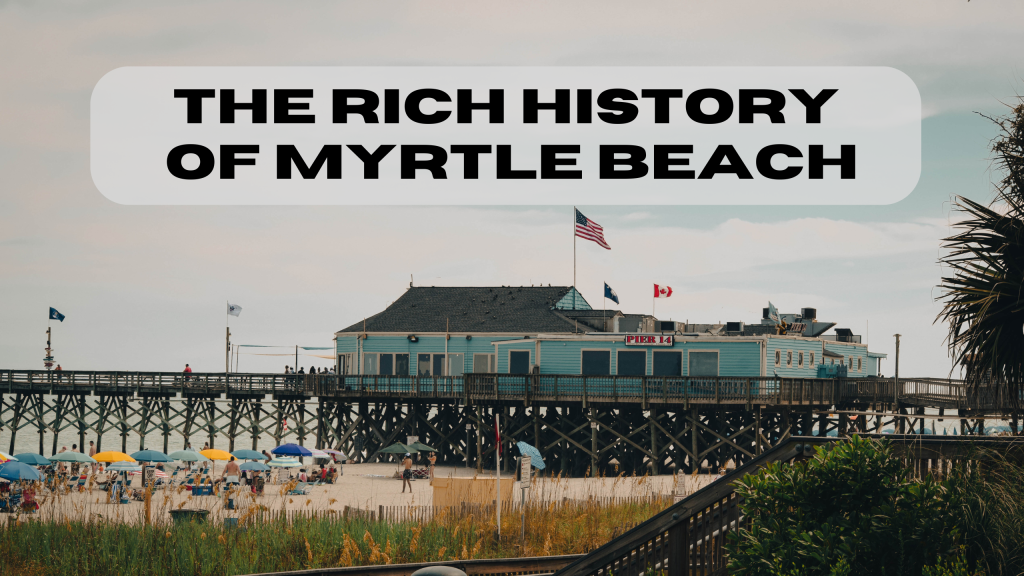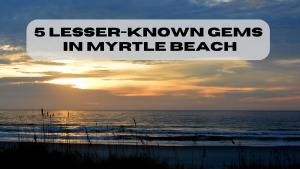Many people flock to Myrtle Beach, South Carolina, because of its gorgeous beaches and vibrant history. This coastal city on the East Coast has evolved from a quiet getaway spot to a bustling tourist attraction. Its changes are rooted in a rich tapestry of cultural, economic, and environmental developments.
People are often stunned at the blend of natural beauty and man-made attractions, making it a great spot for vacationers seeking both relaxation and fun. Understanding the history of Myrtle Beach provides information into how it became the popular resort town it is today, with resilience and innovation through the years.
Key Takeaways
- Myrtle Beach’s rich history, from its early beginnings as a small seaside resort to its status as a major tourist destination, shows how understanding the past can help us appreciate the place more deeply.
- The transformation of Myrtle Beach throughout the 20th century, influenced by important historical events and famous figures, highlights the importance of resilience and innovation in the face of challenges.
- Learning about the cultural impact over the years reveals how Myrtle Beach has been shaped by its visitors and has also significantly influenced American tourism.
- Seeing how Myrtle Beach has evolved, adapting to changes, and embracing prospects can inspire people to be more open to growth and new opportunities.
- The story of Myrtle Beach today, balancing between preserving its rich heritage and increasing development, is a reminder of the importance of growth that respects history and culture.
- Myrtle Beach’s journey from a quiet beach town to a busy city offers valuable insights and lessons for anyone interested in American history or looking for inspiration on how any place can transform over time.
Early Beginnings of Myrtle Beach
Native Tribes
Before tourists came to its sandy shores, the land was inhabited by native tribes. These communities thrived on the abundant resources the coastal and inland areas offered. They hunted, fished, and gathered across the region, living in harmony with the land.
European settlers arrived in the late 17th century, marking a period of change. Interactions between these early settlers and indigenous people varied, from trade to conflict. Over time, these visits reshaped the area’s demographic and cultural landscape.
Resort Destination
By the late 1800s, some saw potential in this coastal area, so they transformed it into a resort destination. The construction of railroads made it accessible to visitors seeking relaxation by the sea. Hotels and amenities sprang up, catering to people looking for a beach getaway.
This time laid the foundation for Myrtle Beach’s future as a popular vacation spot. It signaled the beginning of significant growth that would continue into the next centuries.
Name Origin
The name “Myrtle Beach” was given to the town for the wax myrtle trees dotting its landscape. These trees were not only numerous but also important to the area’s natural beauty. Their abundance led to the naming of the small beach town.
Visitors today might overlook these modest plants will all of the modern attractions. Yet, they remain a living reminder of Myrtle Beach’s natural heritage.
Myrtle Beach in the 20th Century
Intracoastal Waterway
The construction of the Intracoastal Waterway marked a pivotal moment for Myrtle Beach. Completed in the early 1930s, this man-made channel enhanced accessibility to the once-secluded area.
It bridged the gap between remote beaches and bustling cities, paving the way for increased tourism. Tourists now found it easier to get to Myrtle Beach, drawn by its pristine shores and tranquil environment.
Post-War Boom
After World War II ended in 1945, Myrtle Beach witnessed an unprecedented economic boom. The city’s population surged as more people sought its serene lifestyle and business opportunities.
This period saw rapid development, with land being transformed to accommodate growing demands. New roads, homes, and businesses sprouted up, changing the city’s landscape forever.
Modern Attractions
The introduction of major attractions and hotels during the last half of the 20th century really shaped Myrtle Beach’s tourist landscape. Icons like Family Kingdom Amusement Park and Pavilion Amusement Park, established in 1966 and 1948, respectively, became cornerstones of entertainment.
They introduced a blend of thrill and leisure that attracted families from across the nation. With these entertainment spots, luxury hotels offered visitors a comfortable stay, further cementing Myrtle Beach’s status as a premier vacation destination.
Key Historical Events
Hurricane Impact
In 1954, Myrtle Beach encountered a horrible hurricane that reshaped its landscape. The storm, known for its ferocity, demolished buildings and crippled the city’s infrastructure. This event forced local authorities to change the structure of planning and development strategies. They started rebuilding efforts, focusing on stronger construction standards to withstand future calamities.
Tourists today might not see the scars left by the hurricane, but its impact is embedded in the city’s robust structures and emergency preparedness plans. This disaster inadvertently paved the way for modern Myrtle Beach, making it a safer destination for visitors.
Military Presence
The Cold War brought significant changes to Myrtle Beach with the establishment of the Air Force Base in the 1950s. It served as a critical defense point and significantly boosted the local economy by providing jobs and improving infrastructure.
The base became a cornerstone of community life, fostering a unique bond between military personnel and residents. Its closure in the 1990s marked the end of an era but also opened new avenues for urban development and tourism expansion.
Social Movements
Myrtle Beach has witnessed pivotal legal and social movements. Desegregation efforts in the 1960s marked a turning point in its history, promoting equality and inclusivity.
Also, environmental protection initiatives have been crucial in preserving the natural beauty that attracts millions of tourists annually. These movements have not only shaped societal norms but also enhanced tourists’ experiences by fostering a welcoming and sustainable environment.
Myrtle Beach’s Evolution
Seasonal Shifts
Tourists initially came to Myrtle Beach for its summer appeal, enjoying the sand, sun, and sea. This once-seasonal resort has transformed into a year-round destination. They now find attractions that cater to diverse interests, from shopping centers to cultural events happening throughout the year.
The introduction of indoor entertainment options allowed visitors to enjoy Myrtle Beach even when the weather was not ideal. This shift meant that the tourist season no longer ended with summer but extended to all four seasons.
Technological Growth
Technological advancements played a key role as well. The construction of new highways made it easier for tourists from the south and other areas to get to Myrtle Beach. Improved transportation infrastructure also included the expansion of the local airport, which started welcoming flights from new destinations.
These developments made travel more convenient and less time-consuming. As a result, more visitors could easily explore what Myrtle Beach had to offer.
Demographic Changes
The demographic of tourists began to change as well. Initially attracting mostly local families, Myrtle Beach saw an increase in international visitors and golf enthusiasts over time, too. This was due in part to targeted marketing efforts and the development of world-class golf courses like the Tidewater Golf Club, Surf Golf and Beach Club, and the Legends Golf Resort.
Leaders also noticed an uptick in visitors seeking luxurious accommodations and upscale dining options. These changes reflected a broader trend towards more diversified tourism offerings.
Notable Figures in History
Tourism Pioneers
The city of Myrtle Beach was changed from a quiet coastal town into a bustling tourist destination. One entrepreneur was Simeon B. Chapin, who saw the potential in the sandy shores and warm climate. In the early 20th century, he invested heavily in the area’s development, helping to turn it into a place where guests could enjoy leisure and luxury.
Chapin’s efforts led to the construction of hotels and attractions, making it easier for wealthy visitors to book rooms and create memories on memory lane. His vision laid the groundwork for future growth, ensuring that tourism would become a cornerstone of Myrtle Beach’s economy.
Political Leaders
They played crucial roles in shaping the city’s landscape. Mayors and council members worked tirelessly to implement policies that balanced urban development with environmental conservation. They understood that preserving the natural beauty of the beaches and surrounding areas was important to attract more tourists.
Their policies also focused on economic strategies that would benefit both residents and visitors. By making it a welcoming environment for businesses, they ensured that Myrtle Beach could offer a wide range of services and amenities to its guests.
Cultural Icons
Local artists and cultural figures have enriched Myrtle Beach’s cultural landscape as well. Their work in music, art, and performance has added depth to the city’s identity, making it more than just a vacation spot.
These individuals have created festivals, galleries, and performances that celebrate local heritage and talent. Their contributions help tourists understand and appreciate the unique culture of Myrtle Beach beyond its beautiful beaches.
Cultural Impact Over the Years
Music Evolution
Over the years, Myrtle Beach has seen a major shift in its music scene. Initially, beach music dominated, setting the stage for shag dancing’s popularity. This genre, a blend of rhythm and blues with a touch of soul, became common in the area. Tourists and locals would gather at oceanfront pavilions to enjoy live performances, creating a vibrant community around this unique sound.
As time progressed, Myrtle Beach embraced other musical styles. The Carolina Opry became a popular spot for locals and tourists. The Opry House hosts shows all year long, as well as holiday specials.
Country and rock festivals began to take center stage, drawing larger crowds and diversifying the city’s entertainment offerings. These events not only enriched the local culture but also positioned Myrtle Beach as a versatile destination for music lovers.
Dance Tradition
Shag dancing holds a special place in Myrtle Beach’s cultural heritage. This dance form emerged alongside beach music in the mid-20th century. It quickly became a popular hobby on the local scene.
Each year, the city hosts annual shag dance competitions that attract participants from across the country. These events celebrate not just the dance but also the spirit of Myrtle Beach’s social status.
Culinary Influence
Myrtle Beach has significantly impacted regional cuisine over time. The area is renowned for its seafood offerings, reflecting its coastal location. Tourists can explore an assortment of dishes that combine fresh catches with Southern cooking traditions.
From oyster roasts to low-country boils, the culinary landscape here offers a taste of both innovation and tradition. Some popular restaurants also host shows such as the Murder Mystery Dinner Theatre.
Myrtle Beach Today
Current Attractions
Tourists flock to Myrtle Beach for its vibrant attractions and natural beauty. The place boasts a variety of theme parks that provide fun for all ages. Shopping enthusiasts find their paradise at the numerous centers dotting Avenue North.
They also explore the natural preserves, where the local flora and fauna flourish. These spots offer a perfect blend of entertainment and tranquility, making them must-visit destinations.
The beach itself remains a popular spot. Visitors in the summer experience the ideal weather for sunbathing and water sports. Families often opt for a beach home to fully immerse in the coastal lifestyle.
Sustainability Efforts
Amidst development, Myrtle Beach has not turned its back on environmental conservation. The city actively promotes sustainability through various initiatives. They focus on preserving the natural habitats that make this place unique.
Efforts include reducing pollution and promoting eco-friendly tourism practices. These actions reflect a commitment to maintaining Myrtle Beach’s beauty for future generations.
Demographic Changes
The demographic landscape of Myrtle Beach is evolving. This reflects broader societal trends, including an increase in retirees seeking a tranquil lifestyle by the sea. Young professionals are also drawn here, attracted by the growing job market linked to tourism and services.
This mix of populations contributes to a dynamic community spirit, enriching the cultural fabric established over the years.
Future Prospects of Myrtle Beach
Climate Changes
Tourists enjoy Myrtle Beach’s sunny days and warm waters, but climate change poses a significant threat. Rising sea levels and more frequent storms could impact the coastline. Efforts to combat these effects are crucial for its future.
Too Many Tourists
The charm of Myrtle Beach attracts millions, leading to over-tourism. This strain impacts local resources and quality of life. Strategies to manage visitor numbers while maintaining the area’s allure are essential.
Economic Diversification
Relying heavily on tourism, Myrtle Beach faces the challenge of economic diversification. Exploring other sectors can ensure stability against tourism fluctuations.
Infrastructure Projects
Significant investments in infrastructure aim to enhance the experience for visitors and locals alike. Improved roads, public spaces, and facilities contribute to a vibrant Myrtle Beach.
Technological Innovations
Incorporating technology into tourism offers exciting prospects. From virtual reality experiences to enhanced visitor services, innovation will play a key role in attracting future generations.
Tourists and Locals All Love Myrtle Beach
Tourists flock to Myrtle Beach, drawn by its rich history, from its modest beginnings to the major beach town it is today. They witness a locale that has evolved through significant events, influential figures, and cultural shifts.
This journey of transformation showcases Myrtle Beach not just as a vacation spot but as a testament to resilience and growth. It stands today as a vibrant community, poised for future developments while cherishing its past.
The exploration of Myrtle Beach’s history invites further reflection on its role in American culture and its potential trajectory. For those intrigued by this blend of heritage and progress, delving deeper into the city’s story offers valuable insights.
Direction from Myrtle Beach, SC to Chris Walker SEO




